Prehistoric Rock Shelter Sites around the Delta Head on the Lower Mahanadi Valley, Odisha
| Daitari Sahoo |
| Abstract | Results |
| Introduction | Discussion |
| Methodology | Conclusion |
Abstract
Odisha in the central eastern sector of Indian peninsula contains a rich repository of rock art in the form of pictographs and petroglyphs from prehistoric to early historic periods. These incredible evidences of the early human cognizance have very much survived in the rock shelters that are found on the uplands of western Odisha. These archaic rock-habitations are not only found with the different forms of rock art but also along with other artefacts in and around them. The district of Cuttack is located in the eastern part of Odisha forming a major portion of Mahanadi delta. Archaeological field survey recurrently carried out by the present author in different localities of Athagarh, Banki and Cuttack Sadar subdivisions in the district of Cuttack has led to the discovery of a good number of Stone Age sites associated with various lithic artefacts belonging to the lower Palaeolithic, Mesolithic and Neolithic periods. His intensive survey around the delta head on the lower Mahanadi valley in the district has also resulted in the discovery of few rock shelter sites with evidences of typical petroglyphs along with the sites revealing the evidences of prehistoric artefacts in the nearby localities of the rock shelters. The rock shelters are mostly located on the sandstone hills of the Athgarh Gondwana Basin around the delta head of the river Mahanadi. The petroglyphs are found in two different rock shelters sites: one of which is located at the foothills of the Siddheswar Mundia near the village Naraj on the south of the Mahanadi and another at a natural cave on the west of the Haripuli hills in the Subasi Reserve Forest area on the north of the Mahanadi. Besides, the survey in the area has also resulted in the discovery of the remnant of a rock shelter on the Chepetihuri-a low flat hillock of sandstone close to the village Belasahi Saharasahi, a natural cave on the Ashur Tangi hills near the village of Anantapur, and a natural bunker (underground shelter) on the sandstone outcrops of Gondwana formation at the southwestern outskirt of the village Gayalabank on the lower Mahanadi valley in Cuttack district. This paper discusses broadly the archaeology and antiquity of the rock shelter sites investigated in the area.
Keywords: Artefacts, delta-head, gondwana, prehistoric, pictographs, petroglyphs, rock- art, lithic
1. Introduction
With recurrent archaeological field survey in the lower Mahanadi valley since late 1990s to early 2010s the present author has discovered a good number of Stone Age sites evidenced with various lithic artefacts belonging to the lower Palaeolithic, Mesolithic and Neolithic periods. These sites are located at the different localities of Athagarh, Banki and Cuttack Sadar subdivisions in the district of Cuttack. During the survey in the area between 1996-2000 and 2003-2005, a number of natural cliff faces and cavities seem to be rock shelters noticed on the low-lying flat hills of the Athgarh Gondwan Basin on the west of Cuttack. Such natural cliffs faces and cavities are located in hills namely Deolia Mundia at Gayalbank, Barthal Mundia near Pathpur and other small hills in the peripheral forests of Chandaka-Damapara Reserve Forest between Banra-Bhagipur and Charigharia-Chakuleswar localities in Banki subdivision, and in Siddheswar Mundia between Naraj-Marthapur and Talagarh in Cuttack Sadar subdivision on the south of the river Mahanadi in Cuttack district. The low flat hills of sandstone in the Sukasana Reserve Forest in between Megha and Kandarapur villages, Binjhagiri and Saradia hills near Jenapur, Haripuli hills in the Subasi Reserve Forest and Chepetihuri - a low flat hillock in the mixed jungle to the south of the Haripuli hills close to Belasahi Saharasahi village as well as Debikott (Ashur Mundia) - a laterite hill near the village Anantapur on the north of the river Mahanadi in Athagarh subdivision also bear similar features. They are very much noticed on the mid shelves and low-lying escarpments of the hills in this area. All the rest excepting Siddheswar Mundia, Haripuli hills, Chepetihuri, Debikott (Ashur Mundia) are not vividly investigated because of their location in difficult terrain and forested land. Recently in December 2014, the author carried out a short survey around the northeastern foothills of the Deolia Mundia near the Gayala Bank village of Cuttack district on the lower Mahanadi valley. The survey in this area significantly resulted in the discovery of a huge natural bunker (an underground shelter) and a few geoglyphs on the sandstone outcrops of Gondwana formation on the foothills of the Deolia Mundia.
However, only three rock shelter sites as mentioned earlier at Haripuli hills and Chepetihuri close to the village Belasahi Saharasahi, Debikott (Ashur Mundia) at Anantapur on the north of the river Mahanadi in Athagarh subdivision as well as Siddheswar Mundia between Naraj-Marthapur and Talagarh in Cuttack Sadar subdivision and at northeastern foothills of the Deolia Mundia near Gayalabank village in Banki subdivision on the southern valley of the Mahanadi of Cuttack district were taken for vivid investigation. Interest in the rock art study attracted the author to enter into the investigation of rock shelters located around the delta head on the Mahanadi. The rock art sites documented from the survey will be dealt in future. Hence this paper deals only with the rock shelters in the surveyed area, their archeology and antiquity.
2. Contexts and Content of Rock Shelter Sites in Odisha
The state Odisha found its place in the rock art atlas of the world in general and India in particular in early 1930s by the discovery of the one of the earliest testimony of petroglyphs from the rock shelter of Vikramkhol in the district of Jharsuguda, earlier a subdivision of Sambalpur district (Jayaswal, 1933). Subsequently many other scholars like N. P. Chakravarti (1936), Charles Fabri (1936), J. P. Singh Deo (1976), G. C. Mohapatra (1982), Behera (1991-92), Neumayer (1992; 1993) and S. Pradhan (1995-96 ;1997) have contributed to the research on rock art in Odisha by interpreting the inscriptions of Vikramkhol as well as reporting new rock art sites. Besides, during the course of exploration in the districts, the Department of Archaeology and Museums, Government of Orissa, located the painted rock-shelters at Ullaphgarh and Vikramkhol in the district of Sambalpur, situated respectively 8km. north and 13km. south-west of Belpahar Raiway Station, and at Usha-kothi in District Sundargarh (Indian Archaeology1969-70 A Review, p.30). Similarly the Director Cultural Affairs, Government of Orissa, reported the discovery of a prehistoric rock-shelter in the Hemagiri Reserve Forest. The shelter bears paintings depicting hunting of animals, a dancing-scene and animals (Indian Archaeology1969-70 A Review , p.61). However the distribution of rock art sites in eastern sector of Indian peninsula is mostly reported in and around western uplands of Odisha (fig.-1). Pradhan (2001:21-25), within one decade of intensive survey has brought to light a rich heritage of rock art in sixty-six rock shelters in the state. He could able to locate a total of 55 rock art sites with as many as 5775 rock pictures (2241 paintings and 3534 engravings) in the sixty-six natural rock shelters mostly in and around the Bamra hills, Jharsuguda rolling uplands formed in the medium to coarse grained sandstones of the lower Gondwana formation and the granitic outcrops around the Bargarh uplands, Kalahandi uplands. Out of these 55 sites, while in fifteen sites paintings are found; in nine sites are found paintings along with engravings, whereas in the rest thirty-one sites only engravings are found. These rock shelters are strategically painted and engraved on the walls and ceilings, and various stone artefacts, ceramic remains and metal objects are also found embedded on the floors of these rock shelters. The patterns and motifs depicted in the form rock art are a series of geometric and non-geometric figures of intricate and enigmatic characters and repeatedly drawn in the same pattern in painting as well as in engravings. While triangles identical to female genital part are the prime theme in the engravings (petroglyphs) the bisected triangles or triangles with a dot at the centre analogous to vulvas (female genitalia) are the hallmark of all the representations both in painting and engravings. Motifs of palm, foot and cupules are common in style both in engraving and paintings. These rock art greatly include non-thematic and non-figurative abstract symbols and motifs juxtaposed with a few zoomorphic forms. Anthropomorphic figures are absolutely absent in engravings and virtually insignificant in paintings (Pradhan, 2000:647-648; 2003:10-11). Though not an absolute date but a relative chronology has been ascertained basing on an enormous assemblage of archaeological data yielded from the habitation deposits of numerous rock art sites, which reveals that 65 percent of them consists of microliths and about 12 percent yielded pottery remains. Trial excavations at the site of Lekhamoda-VI (LMDVI) yielded three occupational layers such as: Layer (1), Layer (2) and Layer (3) atop the bedrock. Layer (l) yielded an iron chisel; a large amount of wheel made and well-fired pottery remains of red, red slipped and black slipped wares as well as a few noteworthy potsherds of black and red wares along with microliths. The pottery remains from this layer are comparable with the Chalcolithic and Early Historic potteries of the plains. Layer (2) revealed the occurrence of microliths including blades, points, lunates, trapezes, burins, scrapers flakes, fluted cores and flake cores made of chert, chalcedony and quartz; two Neolithic celts – one made of dolerite and the other made of sandstone, three ring/hammer stones along with the mat-impressed handmade potteries associated with usual red ware, red slipped and black slipped wares devoid of engraving and painting on them. Layer (3) atop the bedrock yielded a few representative specimens of microliths including lunates and points made of quartz (Pradhan, 2001:47-48). On the basis of theme, styles of execution, pigmentation, superimposition, state of preservation and the associated findings like stone tools, ceramic remain and the iron implement, a tentative chronology from the prehistoric Mesolithic to the Early Iron Age through, of course the Neolithic-Chalcolithic period (Pradhan, 2000:649;2001:53-55), emerges in the study of the rock art of Odisha
Behera (2001:3) has also reported the distribution of more than hundred small and large natural rock shelters in and around the Deulga hills on the west of Landimal Reserve Forest of Rairakhol subdivision in Sambalpur district. But of all these rock shelters, only fifteen rock shelters contain evidences about the dwellings of prehistoric man and their artistic activities, which show a wide arrangement of petroglyphs. While the rock shelters are conspicuously devoid of paintings or pictographs, the depiction of Petroglyphs are mostly on the front walls and sparsely on the rocky floors of these rock shelters. Majority of the cases the floor of the rock shelters bears evidences of microlithis, heavy duty pebble tools, crudely made potsherds. A large number of conical as well as cylindrical cupules frequently occur in an alignment and are also found on the rocky floor of the rock shelters.

Figure-1: Map of Odisha shows distribution of rock shelters and rock art complexes in four sub geographical regions of Odisha highlands
(Source: P.K. Behera (2001:1-3) Pragdhara, No.11, pp3)
The themes of petroglyphs in the rock art complex of Deulga hills include mostly naturalistic as well as schematic representations of a wide variety of zoomorphic forms comprising fish and birds, animal herding and hunting scenes and a solitary depiction of an anthropomorphic figure. While superimposition of figures is a rare phenomenon in the petroglyphs of Deulga hills, there are a few scenes reported as lizards depicted over ungulates and fertility cult symbol like triangles with or without an oval or elongated-oval engraving in the lower middle section resembling female genitalia engraved on the back of animals suggest rarity of superimposed figures. They were executed by varied degrees of the different reductive methods (such as: pecking, engraving, abrading/scratching and rubbing), as a result of which cross-sections of the engraved lines of petroglyphs possessed shapes either of ‘V’ or ‘U’ patterns. In order to understand the content and context of habitational deposits of the rock shelters, the excavation of a trial pit inside the rock shelter Deulga-1(DLG-1 (Behera, 2001:5-6) identified three broad layers: Layer-1, Layer-2 and Layer-3 based on colour and composition of soil as well as cultural remains within. The cultural remains and skeletal remains retrieved from the Layer-1 include microliths like cores, flakes, blades, bladelets chiefly made of chert, quartz, quartzite and waste raw materials as well as pebble choppers; non-microliths like one Neolithic ground Celt (an axe) made of dolerite and two hammers on quartzite; a few crudely made potsherds, shells of fresh-water bivalves and a few fragments of animal bones. Layer-2 found associated with microliths as in Layer-1and fully devoid of bladelets and non-microliths including a Neolithic ground edged chisel made of dolerite, a quartzite hammer, tip of a bone point, shells of bivalves and gastropods, a few pieces of animal bones and human skeletal remains. Layer-3 includes microliths as in upper two layers and fully devoid of blade types, foliated mica pieces, mollusk shells and a few pieces of animal bones. However, the association of as many as cores, waste products, finished and semi-finished tool types in the three excavated strata of the trial pit in this rock shelter clearly indicate the microliths are onsite production, while the two ground Neolithic artefacts (an axe and a chisel), each one of them found in the upper two strata of the trial pit are offsite production, brought to the site in finished forms (Behera, 2001:5-8). Basing on the circumstantial evidences a tentative chronology from Mesolithic to Neolithic periods may be assigned to the petroglyphs and to the corresponding habitation deposits in the rock art site of Deulga hills (Behera, 2001:10). Nonetheless, based on themes of paintings and engravings, styles of execution, pigmentation, superimposition, state of preservation and the associated findings of the cultural remains like stone tools, ceramic remain and the iron implement, a tentative chronology may be conferred from the Mesolithic to the Early Iron Age, obviously through the Neolithic-Chalcolithic periods for the human occupation and their activities in such rock shelters of Odisha.
3. The Area and Environment
The district Cuttack is located forming a major portion of Mahanadi delta. As mentioned earlier the Athgarh Gondwana Basin occurring within the Mahanadi delta around Bhubaneswar has been known to be the repository of Late Gondwana sediments of lower cretaceous age ( Tiwari et al.1987:1150). The Athgarh Formation is the northernmost extension of the east coast Upper Gondwana sediments of Peninsular India. This formation comprises arenaceous shale, fire-clay, sandstone, grit and conglomerate (Mishra et al, 2004:375). Delta head of the Lower Mahanadi Valley lies on the Upper Gondwana Formation of the Athgarh basin (fig.2). There are numerous low-lying flat hills with vast outcrops and rifts of Athagarh sandstones of the Upper Gondwana Formations around the delta head of the river Mahanadi in the district of Cuttack. Some of the isolated hillocks like Siddheswar Mundia at Talagarh, Debikott at Anantapur, Indrani at Indrani Patana in this belt are well known for their archaeological relics of the early historic to the early mediaeval periods. The lateritic upland with isolated hillocks of older formations is well developed along the western margin of the delta. Geologically, these hills, which prove themselves as the basement of the primary laterites, belong to the Pleistocene periods. The pebbles and gravels of quartz and quartzite of various shapes and sizes, and other tough rocks like sandstone and ferruginous sandstone - suitable for manufacturing of prehistoric artefacts also occur at places on these low-lying hills. The landscapes between hills are covered by thick to thin deposits of red soil and laterites. The river Mahanadi along with its tributaries and distributaries form the drainage system of the district. The area is also considerably drained by some of the perennial and mountain streams like Barajora, Sankhajora and Kiajhor Nala otherwise called as Kianalajora. The Barajora is an affluent of the river Sapua. The river Sapua is the major tributary of the Mahanadi while the Kathjodi is the mighty distributary of the Mahanadi in the locality. It experiences a hot and humid subtropical monsoon climate. While during the summer, the mercury rises as high as 40º Celsius, it dips as low as 10º Celsius during the winter. Summer starts at the end of March and lasts till June when the monsoon sets in. Winter starts from November and lasts till January and is characterized by chill winds from the North. The climate is moderate and pleasant from mid January to mid March in the area. It receives an average annual rainfall of about 1501.3 mm.
.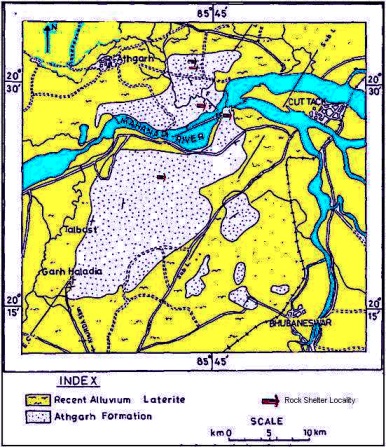
Figure- 2: Geological Map of Athgarh Basin (Toposheet No.73H) after Tiwari et al. 1987:
Current Science, Vol.56 (2), pp. 1151(Modified by author) arrow marks show the location of rock shelters on Upper Gondwana Sandstone of Athgarh Formation.
The hilly tracts around delta head of the Mahanadi is dotted with various indigenous vegetations, on which the local people are very much dependant for their livelihood and household materials. Since time immemorial Savaras are the major tribe living in the area. Their settlements are mostly located close to the aforementioned hills and hillocks.
4. The Rock Shelter Sites
The protracted survey around the delta head of the Mahanadi revealed the existence of prehistoric rock shelters on the cliff faces and cavities of the low-lying hills. Five rock shelter sites are documented from five different places in the study area. Out of these five sites, there are three rock shelter sites without any form of rock art. They are (i) at Chepetihuri otherwise called as Chepeti Mundia near Belasahi Saharasahi, (ii) at Debikott hills (Ashur Tangi or Ashur Mundia) near the village of Anantapur on the north of the Mahanadi and (iii) at the northeastern foot plains of Deolia Mundia near Gayalabank. Rest of the two sites, one at Siddheswar Mundia near the village Naraj on the south of the Mahanadi, and another at Haripuli hills in the Subasi Reserve Forest area on the north of the Mahanadi, are the rock shelters with evidences of rock art - almost in forms of curious petroglyphs. Based on the presence and absence of rock art, the rock shelters sites recorded from the study area may be categorized in to two types such as (i) rock shelters without rock art and (ii) rock shelters with rock art evidences. The geo-archaeology of the three rock shelters without rock art mentioned above is discussed below
4.1. Chepetihuri or Chepeti Mundia (CPH):20 °31'30"N.Latitude, 85 °43'55"E.Longitude.
The Chepetihuri- a low-lying flat hillock of sandstone otherwise known as Chepeti Mundia is located on the south of the Haripuli hills near the village Belasahi Saharasahi in Athgarh subdivision of Cuttack district. It is dotted with knobs and outcrops of sandstones Upper Gondwana formation and sparsely covered with thorny bushes, shrubs and vines of indigenous types. The Kiajhor Nala, a seasonal mountain stream flows from west to east directions on the north of the Chepeti Mundia. Sandstone outcrops and vertical rifts are also found exposed in the eastern escarpment of the northern crest of the hillock. There is a prehistoric site at Bhagidehurikhola on the northern crest of the Chepeti Mundia reportedly known for the evidences of Mesolithic industry ( fig: 3A) and an early shrine (fig: 3C) (Sahoo and Naik 2013:65) in the past. Microliths in abudance including shaped and simple artefacts as well as raw material nodules of chert of different shades, quartz and quartzite are found distributed in this site. From this place, a good number of representative samples of Mesolithic artefacts have been collected which include blades, scraper, point and flakes. The site has also yielded a fragment of the Neolithic tool.
However a thorough survey around the hillock not only recovered a good number of microliths from the site Bhagidehurikhola but also recorded a significant remnant of an east facing rock shelter - a natural cave (fig: 3B) at the sandstone rifts exposed on its eastern flank. It is on the west of the Ghantikhal-Khuntuni road and at about 500m to the south west of the village Belasahi Saharasahi. The ruin of the rock shelter shows a huge vertical cliff of height greater than three meters and width greater than four meters back-wall similar to a natural cave having the roof like overhangs of about 70cm to 1m in length. The back-wall of the rock shelter is vertical and highly eroded while the floor is deposited with roof falls and other eroded materials from its top level. The rock shelter in the site is possibly a natural cave on its last legs because of natural decaying of the sandstone on the ravages of time. Human interference like deforestation, quarrying of stone and soils around the rock shelter might be some other causes of destruction of the same. It is devoid of any forms of rock art due to heavy erosion and collapse of the rooftop. However, occurrence of the microlithic industries and a few neoliths from the nearby sites like Bhagidehurikhola on the west and Belasahi Saharasahi on the north of the dilapidated rock shelter suggests that the rock shelter could have been dwelled by the denizens of Mesolithic and Neolithic periods in the past.
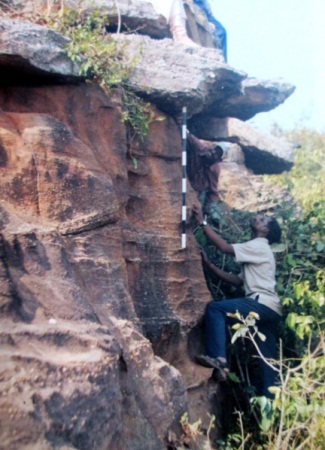
A

B
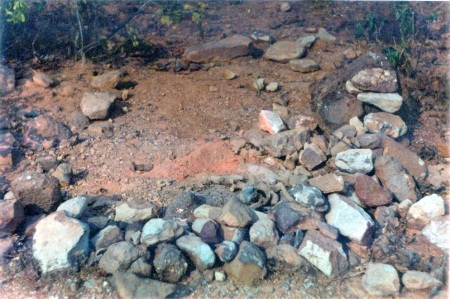
C
Figure-3: A-Ruins of the rock shelter at Chepeti Mundia,
B-Distribution of Microliths at Bhagidehurikhol,
C-Evidence of an early shrine at Bhagidehurikhol atop the Chepeti Mundia.
4.2. Ashur Tangi (AST): 20°28’05”N. Lat; 85°44’45”E. Long.
The Ashur Tangi otherwise called as Ashur Mundia and Ashur Pahar is a flat and low-lying laterite hillock located between the villages of Nuagarh and Ananatapur on the left bank of the Mahanadi in Gurudijhatia P.S. under Athgarh subdivision of Cuttack district. It is also widely known as Debikotta in the locality. The hillock is bounded by the village areas of Bhumibarei on the north, by Anantapur on the east and by the river Mahanadi on the south. The Sapua, a major tributary of the Mahanadi flows on the western boundary of the hillock and meets the Mahanadi to south of the hillock Ashur Tangi.The survey around the hillock resulted in the discovery of three south facing caves on its southern flank. These caves are generally called as Ashur Gumpha (Demons’ Cave) in the locality. Some people also identify these three caves in different names, one as Ashur Gumpha (Demons’ Cave), the second as Bhuashuni Gumpha (Cave of Bhuashuni- an evil spirit) and the third as Debikotta (Cave of Goddess Parvati). Out of these three the caves Ashur Gumpha is found at the highest point while the Bhuashuni Gumpha is situated at about the mid height of the hillock. The Debikotta (Debi means - Goddess Parvati and Kotta means- hollow or cave) is on the east of southern flank located at a level of Ashur Gumpha and meant for worship of Hara-Parvati (Lord Siva and Goddess Parvati). The Ashur Gumpha and Debikotta of the hillock did not yield any cultural deposit due to frequent human interference nowadays. The Bhuashuni Gumpha remained inaccessible due to its dense covering by bushes, vines, termite hills and deposits in its floor area. The Debikotta is comparatively modern than the two others and precisely carved out. Morphologically the Ashur Gumpha is an oval shaped natural cave and the Bhuashuni Gumpha can be compared with the Ashur Gumpha. It can be inferred that the Debikotta might be a natural cave similar to that of Ashur Gumpha but shaped afterward with tough metal instruments.
The Ashur Gumpha near Ananatapur is a natural cave (fig.4A) on the lateritic rift the southern flank of the Ashur Pahar. Thorough study of the cave Ashur Gumpha revealed the carving marks inside it, which suggest that probably some latter attempt was made to carve out the inner space of the same. The eroded flat land on the top of the hillock is highly distributed with various types of microliths and pebbles of quartz, quartzite and chert raw materials (fig.4B). A good number of microliths including cores, flakes, blades, scrapers, burins etc. have been collected from the top of the hill. Occurrence of various simple and shaped microliths, debitages, and raw material pieces on the lateritic surface above the cave on the hillock indicate that most probably the makers and users of microliths were living in the caves of Ashur Gumpha.
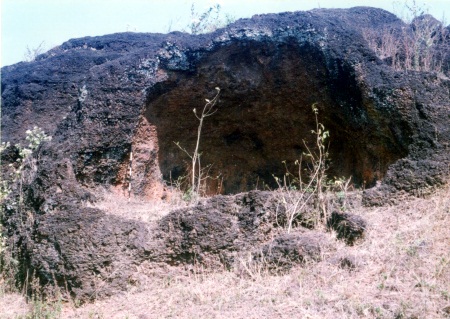
A
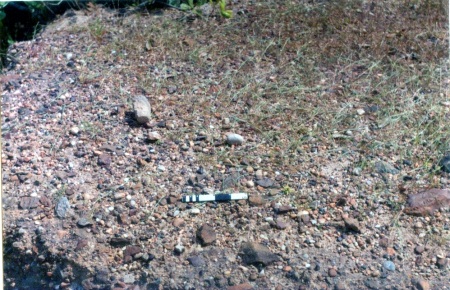
B
Figure-4: A-Ashur Gumpha-a rock shelter at the Ashur Tangi hillock,
B- Distrbution of microliths atop the Ashur Tangi at Anantapur
4.3. Gayala Bank (GLK): 20°28’05”N. Latitude; 85°44’45”E. Longitude
The village Gayalabank on the south of Gobindpur - Banki road is located at the foothill of the Deolia Mundia in Banki subdivision of Cuttack district. There is a vast marshy land on the east of the hills of Deolia Mundia near the village is also widely known as the Gayalabank Pata. A number of rock shelters are noticed during the earlier survey on the eastern flank of the Deolia Mundia (fig: 5). Recently, a short survey conducted on the outcrops of Gondwana sandstone exposed at the eastern foothills and foot plains between Deolia Mundia (fig: 6A&B) on the west and the Gayalabank Pata on the east. The survey in this part resulted in the discovery of a natural bunker (an underground rock shelter) ( fig: 7A&B) deposited with hill washes like pebbles and gravels as well as brown silt. A fragment of well ground and polished grinding stone - probably a muller made on basalt rock (fig: 8A&B) found as in situ fixed at the ground level on the left wall close to the orifice of the underground shelter. It seems to be a huge burrow with an oval orifice, arced rooftop and a spacious floor. One can enter into it in sitting or crawling position. Rooftop of the rock shelter is smooth and comparatively intact. The author could able to locate the bunker with the help of Shri Trilochan Rana, a resident of the Mahapatra Mali Sahi of the village Gayalabank. According to Shri Rana, earlier the bunker was filled with hill washes; recently it was cleaned and made habitable by a young man of the Gayalabank village. In fact the young man is living in this bunker making some arrangement inside and outside of it. Fragment of a muller is the only lithic evidence found from the bunker suggests its antiquity from which it may be inferred that the bunker could have been occupied by the mankind since the Neolithic period. Though a small amount of Stone Age artifacts, most probably belonging to the period from Palaeolithic to Mesolithic, were obtained from the surrounding landscape in proximity of the site but such lithic evidences may not be linked to the antiquity of the underground rock shelter. However, an intensive study with an excavation of the inside deposits of the bunker is quite essential. The excavation of the existing fills at the floor area and vivid search at the ceilings of the arced rooftop may reveal substantial data for reconstruction of archaeology of the area

Figure -5: Rock shelter complex on the eastern flank of the Deolia Mundia
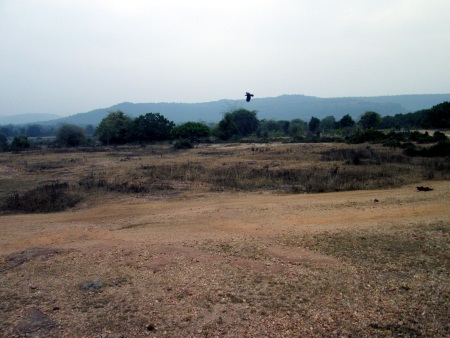
A
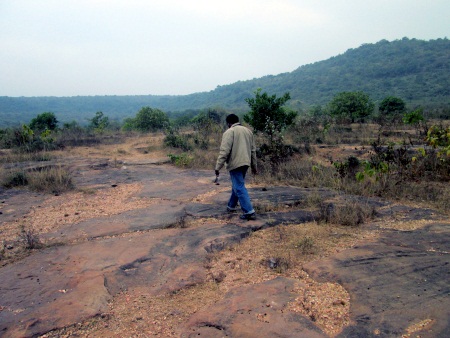
B
Figure-6A&B: Partial Geomorphology of the foot plains of the Deolia Mundia at the site of Gayalabank and the author is at survey work.

A
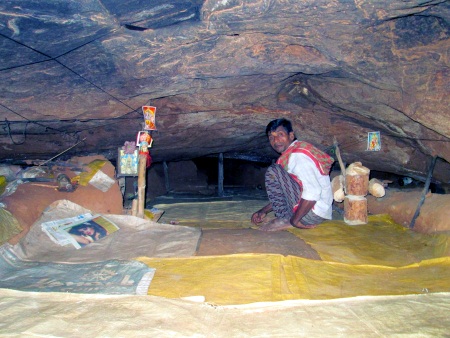
B
Figure-7: A- The Natural Bunker (Underground Rock Shelter) on the foothills of the Deolia Mundia near Gayalabank;
B-Inside view of the bunker at Gayalabank and Shri Trilochan Rana, the informant is inside the bunker
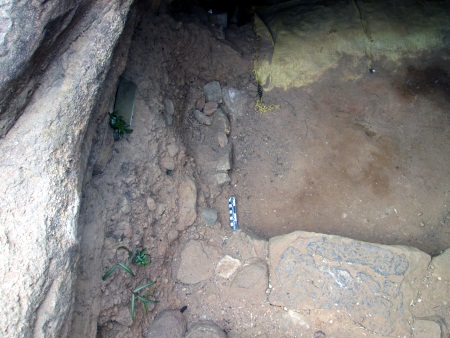
A
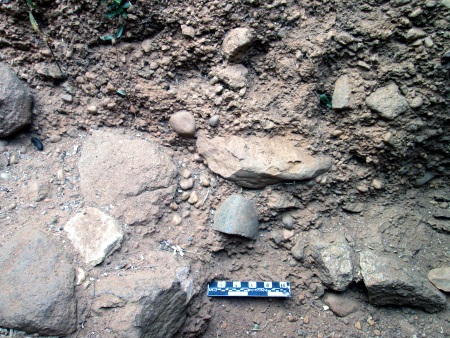
B
Figure-8 A- Fragment of the Grinding Stone (Muller) as in situ at the ground level on the left wall close to the orifice of bunker;
B-Close view of the same grinding stone made on basalt.
5. Conclusion
Author’s frequent fieldwork around the delta head of the Mahanadi to the west of Cuttack not only revealed the existence of prehistoric sites but also helped locating and documenting the rock shelters on the low-lying sandstone hills in the Gondwana Basin of Athgarh formation. The rock shelters are mostly found at the cliff faces and cavities naturally formed on the low-lying flat hills in the study area. Altogether five rock shelter sites have been documented at different places from the study area. On the basis of availability of rock art, the rock shelter sites documented from the study area are classified into two categories: (i) the rock shelters without rock art and (ii) the rock shelters with any form of rock art. In fact the rock shelter sites with rock art in the area motivated the author to devote himself in the study of the rock shelters located in the Lower Mahanadi valley in general and around the delta head of the Mahanadi in particular. These rock shelters having vast open frontages are located close to the seasonal and perennial streams or vast marshland. From the altitudinal point of view, the shelters are situated at varied heights ranging from minimum 35m to maximum 95m aMSL. Most of the rock shelters are in fact destroyed or on the verge of collapse due to the ravages of time and/ or willful exploitation of the rocks like sandstones and laterite, mineral like fireclay as well as other natural resources. However there are three rock shelter sites without rock art; while the rock shelters at Chepetihuri and Ashur Tangi are on the hill flanks, the rock shelter at Gayalabank is a bunker (an underground shelter) naturally formed on the ground level. As near these rock shelter sites, are found stone artifacts (like choppers, hand axes, scrapers, and microliths of different typologies), broken neoliths (like ground and polished axes, chisel, ring stone) and also microlithis in abundance, an inference can not be ignored that these rock shelter sites might have been old enough to belong to some time between Mesolithic and Neolithic periods and could have been dwelled by the people of that period. Significantly, an ancient shrine, a kind of circular religious structure made of nodules and boulders of various shapes and sizes, associated with handmade terracotta animal figurines and a kind of powdery material of saffron hue probably ochre found to be located at the nearest places of the rock shelter at Chepeti Mundia suggests the possibility of certain religious practices amongst the dwellers inhabiting the rock shelter sites. The study of the rock shelters with rock art in the surveyed area may suggest the possibility of other cultural practices amongst such dwellers. This aspect of the study will be reported in another paper.
Acknowledgements
Special thanks are due to Shri Subrat K. Naik, student in Prehistoric Archaeology special paper, Shri Tarunkanti Mohapatra, photographer-cum-artist, Department of Anthropology, Utkal University, Shri Manas Dhar and Shri Trilochan Rana, the resident of Gayalabank village for their tireless assistance during the field survey.
References
-
Behera, P. K.(1991-92). Prehistoric Rock Art Paintings to fertility Cult and Other Subjects of Orissa. Pragdhara, 2,7-17.
-
Behera, P.K.(2001). Investigation into the Newly Discovered Rock Art Sites of Deulga hills, Orissa. Pragdhra, 11, 3-11.
-
Chakravarti, N.P. (1936).The Vikramkhol Rock Inscription. Annual Report of Archaeological Survey of India, 1930-34, I: 229.
-
Fabri, C.L. (1936). The Vikaramkhol Rock Inscription, Editorial remark, Annual Report of Archaeological Survey of India, 1930-34, I: 230.
-
Jayswal, K.P. (1933). The Vikramkhol Inscriptions, Sambalpur District, The Indian Antiquary, Vol. LXII: 58-60.
-
Indian Archaeology,1969-70. A Review, pp.30; Orissa (43) Exploration in Districts of Sambalpur and Sundargarh.
-
Indian Archaeology, 1969-70. A Review, pp.61 (15) Prehistoric Rock-Shelter, Hemagiri, District Sundergarh.
-
Mishra, B, K., Pandey, L. and Maejima, W. (2004). Alluvial Fan - Lacustrine Sedimentation and its Tectonic Implications in the Cretaceous Athgarh Gondwana Basin, Orissa, India. Gondwana Research, 7(2):375-385.
-
Mohapatra, G.C. (1982). Notes on the Vikramkhol and Ushakothi Rock Shelters in Orissa, Man and Environment , VI, 97-100.
-
Neumayer, E. (1992). Rock pictures in Orissa. Puratattyva 1991-92, 22: 13-24.
-
Neumayer E. (1993). Lines on Stone, The Prehistoric Rock Art of India, Manohar Publisher and Distributors, New Delhi.
-
Pradhan, S. (1995-96). Rock Engraving in the Rock Shelters of Upland Orissa, Puratattva, 26:32- 42.
-
Pradhan, S. (1997). Prehistoric Art. In P.K. Mishra & J.K. Samal (ed). Comprehensive History and Culture of Orissa. Kaveri Books, New Delhi: 46-53.
-
Pradhan, S. (2000). Rock Art of Orissa. In K.K. Basa & P.Mohanty (ed). Archaeology of Orissa, Vol.II :635-650, Delhi, Pratibha Prakashan.
-
Pradhan, S. (2001). Rock Art in Orissa, Aryan Books International, New Delhi.
-
Pradhan, S. (2003). Rock Art Heritage in Orissa. Souvenir, Orissa History Congress Silver
-
Jubilee Session (2nd-3rd November, 2003). P.G.Department of History Sambalpur Univrsity, Jyoti Vihar.pp.-12).
-
Sahoo, D. and Naik, S. K. (2013). Stone Age Cultures around Ghantikhal Area, Cuttack District, Coastal Odisha. Man in Society, Vol.20:56-80. The Journal of Anthropology, Department,Utkal University, Bhubaneswar.
-
Singh Deo, J.P. (1976). Prehistoric Cave Painting of Jogimath Donger, The Orissa Historical Research Journal , Vol.XXII, No.2: 21-22.
-
Tiwari, R.S., Tripathi, A., Dutta A.B. and Mukhapadhyay, A.(1987) Palinological Dating of Olive-Green Shales underlying the Athagarh Sandstone in Mahanadi Basin. Current Science , November 20, Vol.56 (2):1150-1153.
*Address for Correspondence: Shri Daitari Sahoo, Senior Lecturer in Prehistoric Archaeology, P.G. Department of Anthropology (U. G. C. Centre of Advanced Studies), Utkal University, Bhubaneswar -751 004. Email: This email address is being protected from spambots. You need JavaScript enabled to view it.



